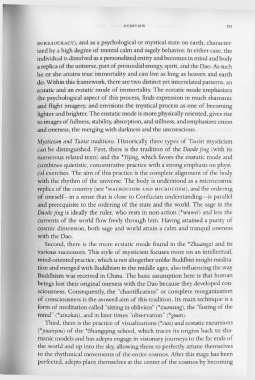Page 161 - The Encyclopedia of Taoism v1_A-L
P. 161
OVERVIEW 121
BUREAUCRACY), and as a psychological or mystical state on earth, character-
ized by a high degree of mental calm and sagely behavior. In either case, the
individual is dissolved as a personalized entity and becomes in mind and body
a replica of the universe, part of primordial energy, spirit, and the Dao. As such
he or she attains true immortality and can live as long as heaven and earth
do. Within this framework, there are two distinct yet interrelated patterns, an
ecstatic and an enstatic mode of immortality. The ecstatic mode emphaSizes
the psychological aspect of this process, finds expression in much shamanic
and flight imagery, and envisions the mystical process as one of becoming
lighter and brighter. The enstatic mode is more physically oriented, gives rise
to images of fullness, stability, absorption, and stillness, and emphasizes union
and oneness, the merging with darkness and the unconscious.
Mysticism and Taoist traditions. Historically three types of Taoist mysticism
can be distinguished. First, there is the tradition of the Daode jing (with its
numerous related texts) and the *Yijing, which favors the enstatic mode and
combines quietistic, concentrative practice with a strong emphasis on physi-
cal exercises. The aim of this practice is the complete alignment of the body
with the rhythm of the universe. The body is understood as a microcosmic
replica of the country (see *MACROCOSM AND MICROCOSM), and the ordering
of oneself- in a sense that is close to Confucian understanding-is parallel
and prerequisite to the ordering of the state and the world. The sage in the
Daode jing is ideally the ruler, who rests in non-action (*wuwei) and lets the
currents of the world flow freely through him. Having attained a purity of
cosmic dimension, both sage and world attain a calm and tranquil oneness
with the Dao.
Second, there is the more ecstatic mode found in the *Zhuangzi and its
various successors. This style of mysticism focuses more on an intellectual,
mind-oriented practice, which is not altogether unlike Buddhist insight medita-
tion and merged with Buddhism in the middle ages, also influencing the way
Buddhism was received in China. The basic assumption here is that human
beings lost their original oneness with the Dao because they developed con-
sciousness. Consequently, the "chaotification" or complete reorganization
of consciousness is the avowed aim of this tradition. Its main technique is a
form of meditation called "sitting in oblivion" (*zuowang), the "fasting of the
mind" (*xinzhai), and in later times "observation" (*guan).
Third, there is the practice of visualizations (*cun) and ecstatic excursions
(*yuanyou) of the *Shangqing school, which traces its origins back to sha-
manic models and has adepts engage in visionary journeys to the far ends of
the world and up into the sky, allowing them to perfectly attune themselves
to the rhythmical movements of the entire cosmos. After this stage has been
perfected, adepts place themselves at the center of the cosmos by becoming

